 W
WAcanthoponera mucronata is a species of ant belonging to the genus Acanthoponera. Described in 1860 by Roger, the species is native to South America.
 W
WAmmophila urnaria is a species of hunting wasp in the family Sphecidae. It is a black and red insect native to the eastern United States. It feeds on nectar but catches and paralyses caterpillars to leave in underground chambers for its developing larvae to consume.
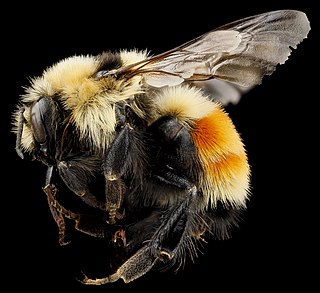 W
WBombus huntii is a species of bumblebee. It is native to western North America, where it occurs in western Canada and the United States as far east as Manitoba and Minnesota, and in Mexico as far south as the Trans-Mexican Volcanic Belt. It is known commonly as the Hunt bumblebee or Hunt's bumblebee.
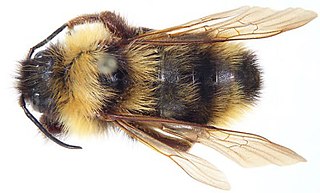 W
WBombus suckleyi is a species of bumblebee known commonly as Suckley's cuckoo bumblebee, named after biologist George Suckley. Suckley's bumble bee is a generalist pollinator and represents a rare group of obligate, parasitic bumble bees. Suckley's bumble bee is a social-parasite because it invades the nests of the host bumble bees, including the western bumble bee, and relies on host species workers to provision its larvae. It is native to northwestern North America, including Alaska and parts of western and central Canada and the western United States.
 W
WBombus wurflenii is a species of bumblebee found in several parts of central and northern Europe to Turkey and the Crimea peninsula in the southeast.
 W
WCamptonotus carolinensis, the Carolina leaf-roller, is a species of raspy cricket in the family Gryllacrididae. It is found in North America.
 W
WCheilosia carbonaria is a European species of hoverfly. Like most Cheilosia it is black, and because of this may often be overlooked as a hoverfly. It is little recorded, and is considered rare and scarce throughout most of its range.
 W
WChironomus anthracinus is a species of fly in the family Chironomidae. It is found in the Palearctic.
 W
WEctatomma ruidum is a Neotropical species of ant in the subfamily Ectatomminae.
 W
WElattoneura glauca is a species of damselfly in the family Platycnemididae known commonly as the common threadtail and grey threadtail. It is native to the southern half of the African continent, where it is widespread. It lives in shady areas along rivers and streams.
 W
WThe false garden mantis is one of the most common species of mantis in Australia. Females reach 70 mm while males reach 50 mm.
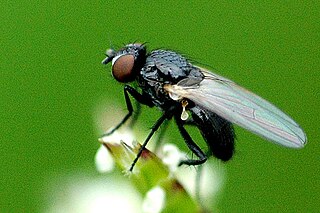 W
WFannia lucidula is a fly species in the Fanniidae family. This species is smaller and more slender than the house fly, Musca domestica, and is similar in appearance to the lesser house fly, Fannia canicularis.
 W
WHelina trivittata is a fly from the family Muscidae.
 W
WThe juniper shield bug, , is a large (9-10.5 mm) green shield bug with distinctive pinkish-red markings on the corium.
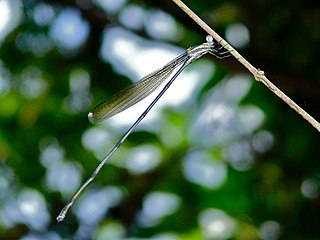 W
WMecistogaster modesta is a species of narrow-winged damselfly in the family Coenagrionidae. It is found in Central America.
 W
WMeconema meridionale is an insect in the family Tettigoniidae, known as the southern oak bush cricket.
 W
WMegachile pluto, also known as Wallace's giant bee or raja ofu/rotu ofu, is a very large Indonesian resin bee. It is the largest known living bee species. It was believed to be extinct until several specimens were discovered in 1981. There were no further confirmed sightings until two were collected and sold on eBay in 2018. A live female was found and filmed for the first time in 2019.
 W
WMicromus tasmaniae the Tasmanian Brown Lacewing, is a species of brown lacewing in the family Hemerobiidae.
 W
WMicronecta scholtzi is a species of lesser water boatman in the family Corixidae in the order Hemiptera. It was first described by Franz Xaver Fieber in 1860. They are some 2 mm long and are common in freshwater ponds and lakes across Europe, preferring stagnant to moderately moving water. In Central Europe, the genus Micronecta is represented by five species, as follows:Micronecta (Dichaetonecta) pusilla Micronecta (Dichaetonecta) scholtzi Micronecta (Micronecta) griseola Géza Horváth, 1899 Micronecta (Micronecta) minutissima Micronecta (Micronecta) poweri
 W
WMicrostigma rotundatum, the helicopter damselfly, is a species of damselflies belonging to the family Pseudostigmatidae.
 W
WMyopopone castanea is a species of ant in the genus Myopopone. It was described by Smith in 1860.
 W
WThe orange threadtail or ochre threadtail is an Australian damselfly in the family Platycnemididae. They are medium-sized with a length of around 35mm. Orange threadtails can be found near semi-shaded running water, and usually rest on plants at the water's edge. Orange threadtails may be seen all year round. In Victoria they occur at lower altitudes during summer, though further north they can be seen in spring and autumn. When at rest, Nososticta damselflies hold their wings closely folded up vertically over their thorax. The male threadtails have an orange-yellow thorax with black patterns. Their abdomen is narrow, black in colour with yellow strips. There is a brown yellow colour at the base of their wings. Females are the same size as the males. They are pale brown in colour and have the same black patterns as the males.
 W
WParagryllacris combusta or the striped raspy cricket is a species of cricket found in Australia.
 W
WPemphigus spyrothecae, or the poplar spiral gall aphid, is a social insect which exhibits apparent altruistic behaviors. The aphids form galls and act as colony defenders, at times sacrificing their own lives to do so. It has been shown that colony defense is more likely in habitats that are difficult to obtain and can hold a large number of individuals. These gall locations are crucial because plants have a short window in which a gall can be produced. Thus, it is important for there to be a defense system that enables the aphids to retain their galls. The need for defense arises when the gall is opened up to allow winged aphid migrants to leave and to release any waste. The process of repairing the holes can take up to 10 days; during this time, the gall is susceptible to intruding predators.
 W
WPhasia aurigera is a species of tachinid fly.
 W
WPhylloneura westermanni, Myristica bambootail is a damselfly species in the family Platycnemididae. It is endemic to Myristica swamps of Western Ghats in India. The habitat is restricted to a few localities in Karnataka, Kerala and Tamil Nadu.
 W
WProceratium croceum is a species of ant in the family Formicidae.
 W
WProdasineura verticalis is a damselfly in the family Platycnemididae. It is commonly known as the red-striped black bambootail or black bambootail.
 W
WSciocoris microphthalmus is a species of stink bug in the family Pentatomidae. It is found in Europe & Northern Asia, North America, and Southern Asia.
 W
WAtta texana is a fungus-farming ant species of the genus Atta, found in Texas, Louisiana, and northeastern states of Mexico. Common names include town ant, parasol ant, fungus ant, Texas leafcutter ant, cut ant, and night ant. It harvests leaves from over 200 plant species, and is considered a major pest of agricultural and ornamental plants, as it can defoliate a citrus tree in less than 24 hours. Every colony has several queens and up to 2 million workers. Nests are built in well-drained, sandy or loamy soil, and may reach a depth of 6 m (20 ft), have 1000 entrance holes, and occupy 420 m2 (4,500 sq ft).
 W
WToxotrypana curvicauda, the papaya fruit fly, is a species of fruit fly in the family Tephritidae.
 W
WTropidomantis tenera or Tropidomantis (Tropidomantis) tenera is a species of praying mantis found in Thailand, Malaysia, Sumatra, Java, Flores, Sumba, Sulawesi, Borneo, and the Philippines. Females reach about 2.5 cm in length, and males are smaller.
 W
WMegachile pluto, also known as Wallace's giant bee or raja ofu/rotu ofu, is a very large Indonesian resin bee. It is the largest known living bee species. It was believed to be extinct until several specimens were discovered in 1981. There were no further confirmed sightings until two were collected and sold on eBay in 2018. A live female was found and filmed for the first time in 2019.
 W
WYersinella raymondi, common name Raymond's Bush-cricket, is a species of "katydids crickets" belonging to the family Tettigoniidae subfamily Tettigoniinae. The scientific name Yersinella comes from the name of the entomologist who has described the species in 1860.
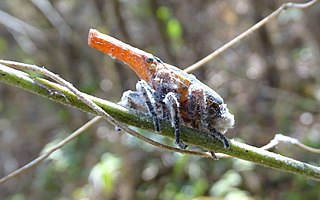 W
WZanna madagascariensis, the Malagasy lantern bug, is endemic to Madagascar. It is a member of the Zanninae, considered to be a subfamily of the Fulgoridae. The nymphs are sometimes referred to as lantern-flies because of their large lantern like snout, although this does not emit light. The adult bugs are known as sakandry, and are consumed by the rural people of Madagascar. Roasted whole, they are reported to taste like bacon.